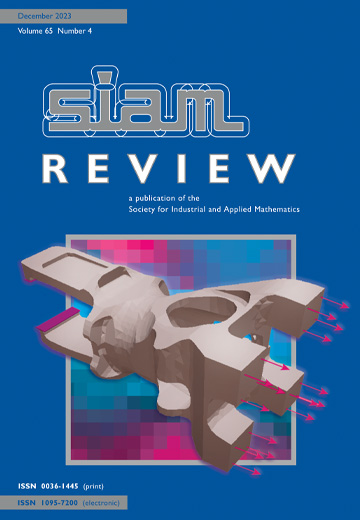Education
IF 6.1
1区 数学
Q1 MATHEMATICS, APPLIED
引用次数: 0
Abstract
SIAM Review, Volume 65, Issue 3, Page 867-867, August 2023.In this issue, the Education section presents two contributions. “The One-Dimensional Version of Peixoto's Structural Stability Theorem: A Calculus-Based Proof,” by Aminur Rahman and D. Blackmore, proposes, in the one-dimensional setting, a novel proof of Peixoto's structural stability and density theorem, which is fundamental in dynamical systems theory. In this framework the structural stability theorem says that a $C^1$ dynamical system $\dot x =f(x)$ on $\mathbb{S} ^1$ is structurally stable if and only if it has finitely many equilibrium points, all of which are hyperbolic. In the above $\mathbb{S} ^1$ denotes the unit circle in $\mathbb{R}^2$ and a point $x_\star$ is called hyperbolic if $f'(x_\star) \neq 0$. The Peixto density result says that the set of all $C^1$ structurally stable systems on $\mathbb{S}^1$ is open and dense in the space of all $C^1$ dynamical systems on $\mathbb{S} ^1$ endowed with the $C^1$ norm. The original Peixoto's theorem is more complex and is valid for any smooth closed surface. Its proof, however, is long and not accessible using the tools available to advanced undergraduates, in contrast with the proposed one-dimensional proof, which an undergraduate could follow. This does not mean that the proof itself is elementary. Preliminaries recall all the basic definitions that are needed to successfully conduct the task. The style is rigorous and self-contained. The article also provides some historical comments, making the reading lively and encouraging further learning. The second paper, “Piecewise Smooth Models of Pumping a Child's Swing,” is presented by Brigid Murphy and Paul Glendinning. It concerns models of a child, in either a seated or standing position, swinging on a playground swing. In the article, which arose from the MSc dissertation by one of the authors, these models are analyzed using Lagrangian mechanics and may serve as an introduction to the different ways in which piecewise smooth systems do arise in modeling. The authors describe control strategies of swingers, and, in particular, whether it is possible for the swing to go through a full turn over its pivot. Piecewise smooth terms do naturally appear while discussing the strategies, and this future is analyzed in detail. Indeed the instantaneous reposition of the body of the swinger leads to a jump in the configuration of the swing. Numerical simulations are performed with a standard software package. These investigations would be suitable for undergraduate projects related to classical mechanics courses. At a higher degree level, projects could include further refinement of the existing methods and/or getting more accurate numerical solutions using available specialized software packages. The final section also discusses various related mathematical questions that would be interesting to investigate in this context and mentions other models involving jumps described using piecewise smooth terms.
教育
SIAM评论,第65卷第3期,第867-867页,2023年8月。在本期中,教育部分提供了两个贡献。Aminur Rahman和D.Blackmore的“Peikodo结构稳定性定理的一维版本:基于微积分的证明”,在一维环境中提出了Peikoto结构稳定性和密度定理的新证明,这是动力系统理论的基础。在这个框架中,结构稳定性定理表明,$\mathbb{S}^1$上的$C^1$动力系统$\dot x=f(x)$是结构稳定的,当且仅当它有有限多个平衡点,所有这些平衡点都是双曲的。在上面的$\mathbb{S}^1$表示$\mathbb{R}^2$中的单位圆,如果$f'(x_\star)\neq0$,则点$x_\star$称为双曲点。Peixto密度结果表明,在$\mathbb{S}^1$上所有结构稳定的$C^1$系统的集合在$\math bb{S}^1$上所有具有$C^1$范数的$C^ 1$动力系统的空间中是开的和稠密的。原来的Peikodo定理更为复杂,适用于任何光滑的闭曲面。然而,与本科生可以遵循的一维证明相比,它的证明很长,使用高级本科生可用的工具是不容易获得的。这并不意味着证明本身就是基本的。前言回顾了成功执行任务所需的所有基本定义。风格严谨,自成一体。文章还提供了一些历史评论,使阅读变得生动,并鼓励进一步学习。第二篇论文“儿童挥杆的分段平滑模型”由Brigid Murphy和Paul Glendining提出。它涉及一个孩子的模型,无论是坐着还是站着,在操场上荡秋千。这篇文章源于其中一位作者的硕士论文,使用拉格朗日力学对这些模型进行了分析,并可以介绍在建模中出现分段光滑系统的不同方式。作者描述了挥杆者的控制策略,特别是挥杆是否有可能在其枢轴上完成一个完整的转弯。在讨论策略时,分段平滑术语确实会自然出现,并对未来进行了详细分析。事实上,挥杆者身体的瞬间重新定位导致挥杆配置的跳跃。使用标准软件包进行数值模拟。这些研究将适用于与经典力学课程相关的本科生项目。在更高的学位水平上,项目可以包括进一步完善现有方法和/或使用可用的专业软件包获得更准确的数值解。最后一节还讨论了在这种情况下值得研究的各种相关数学问题,并提到了使用分段平滑项描述的涉及跳跃的其他模型。
本文章由计算机程序翻译,如有差异,请以英文原文为准。
求助全文
约1分钟内获得全文
求助全文
来源期刊

SIAM Review
数学-应用数学
CiteScore
16.90
自引率
0.00%
发文量
50
期刊介绍:
Survey and Review feature papers that provide an integrative and current viewpoint on important topics in applied or computational mathematics and scientific computing. These papers aim to offer a comprehensive perspective on the subject matter.
Research Spotlights publish concise research papers in applied and computational mathematics that are of interest to a wide range of readers in SIAM Review. The papers in this section present innovative ideas that are clearly explained and motivated. They stand out from regular publications in specific SIAM journals due to their accessibility and potential for widespread and long-lasting influence.
 求助内容:
求助内容: 应助结果提醒方式:
应助结果提醒方式:


